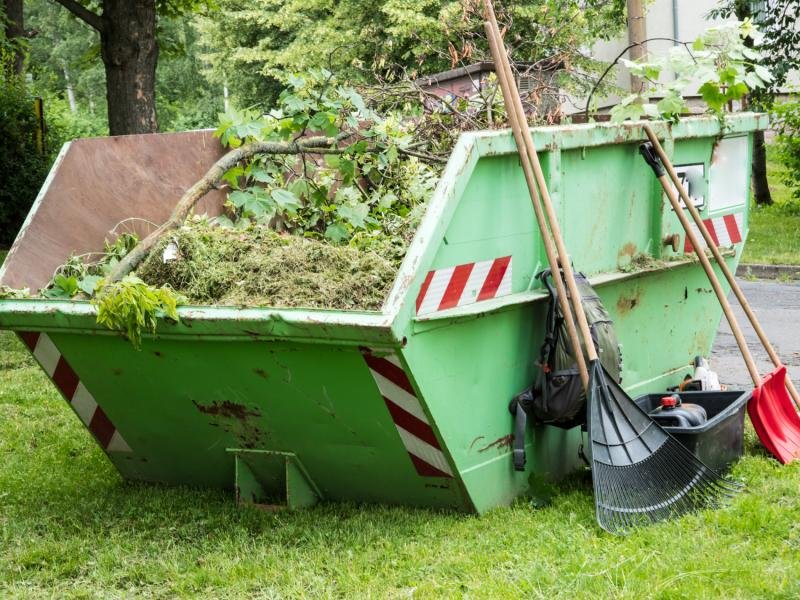Yard waste typically refers to organic materials from gardens and lawns, like leaves, grass clippings, and branches. Green waste encompasses a wider range of organic materials, such as kitchen scraps, coffee grounds, and even certain food waste. Proper disposal and recycling of these materials are crucial for environmental sustainability.
Composting yard and green waste can significantly reduce landfill usage and produce valuable compost for gardens. Understanding these terms helps in effective waste management and promotes eco-friendly practices. Always segregate your waist to ensure it gets recycled properly.

Definition Of Yard Waste And Green Waste
Many people wonder about the difference between yard waste and green waste. Both terms are related to garden and lawn debris. Understanding these terms can help in proper waste disposal. This blog post will define both yard waste and green waste.
What Is Yard Waste?
Yard waste consists of organic materials from your garden or lawn. This includes grass clippings, leaves, and twigs. It often accumulates from regular lawn maintenance.
Yard waste can be classified into different types:
- Grass clippings
- Leaves
- Twigs and branches
- Old plants and weeds
Proper disposal of yard waste is important. Many communities have specific collection days for yard waste. Some areas offer composting programs. This helps reduce landfill waste.
Here is a simple table to differentiate common types of yard waste:
| Type of Yard Waste | Example |
| Grass Clippings | After mowing the lawn |
| Leaves | Fallen leaves in autumn |
| Twigs and Branches | Pruned tree limbs |
| Old Plants and Weeds | Dead flowers, pulled weeds |
What Is Green Waste?
Green waste is a broader term. It includes many of the same items as yard waste. Green waste can also include kitchen scraps and other organic materials.
Examples of green waste include:
- Fruit and vegetable scraps
- Coffee grounds
- Eggshells
- Flowers and plant trimmings
Green waste is often used for composting. Composting is the process of turning organic waste into nutrient-rich soil. This helps gardens grow better.
Here is a simple table to show common types of green waste:
| Type of Green Waste | Example |
| Fruit and Vegetable Scraps | Banana peels, carrot tops |
| Coffee Grounds | Used coffee filters |
| Eggshells | Crushed eggshells |
| Flowers and Plant Trimmings | Wilted flowers, pruned leaves |
Differences Between Yard Waste And Green Waste
Yard waste and green waste are often used interchangeably. But they are not the same. Understanding their differences can help in proper waste management. Yard waste usually refers to organic materials from gardens and lawns. Green waste, on the other hand, includes a broader range of organic materials. This article will help you understand the key differences between yard waste and green waste.
Composition
The composition of yard waste and green waste differs significantly.
Yard waste generally includes:
- Grass clippings
- Leaves
- Twigs
- Small branches
Green waste encompasses a wider range of materials.
This type of waste can include:
- Food scraps
- Vegetable peels
- Fruit skins
- Coffee grounds
Yard waste is mostly generated from garden maintenance. Green waste often comes from kitchens and food processing areas. Both types of waste are organic, but their sources differ. Yard waste is primarily plant-based. Green waste has more variety, including food items.
Management Practices
Management practices for yard waste and green waste also differ. Yard waste management often involves:
- Composting
- Mulching
- Landfill disposal
Green waste management may include:
- Composting
- Vermicomposting (using worms)
- Biogas production
Composting is a common method for both types of waste. Yard waste composting is simpler. Green waste composting needs more care because of food scraps. Biogas production is unique to green waste. This method turns food waste into energy. Mulching is mostly used for yard waste. It helps in soil enrichment and moisture retention.
Proper management of these wastes can reduce landfill use. It can also produce useful products like compost and biogas. Understanding these practices can help in effective waste management.
Environmental Impact Of Yard Waste And Green Waste
Yard waste and green waste are often thought to be the same, but they have some differences. Yard waste includes leaves, grass clippings, branches, and other garden debris. Green waste, on the other hand, consists of organic waste like fruit and vegetable scraps, coffee grounds, and other compostable materials. Understanding these differences helps us manage waste better and reduce environmental harm. Let’s explore the environmental impact of yard waste and green waste.
Effect On Landfills
Yard waste and green waste both affect landfills, but in different ways. Yard waste takes up a lot of space in landfills. This reduces the space available for other types of waste. Over time, yard waste can break down and produce methane gas, a potent greenhouse gas. This gas contributes to global warming.
Green waste, when not composted, also ends up in landfills. Like yard waste, it breaks down and produces methane gas. Composting green waste can help reduce this problem. By turning green waste into compost, we can improve soil health and reduce landfill waste.
Here are some key points about the effects of yard waste and green waste on landfills:
- Space Consumption: Both types of waste take up valuable landfill space.
- Methane Production: Decomposing waste produces methane, a harmful greenhouse gas.
- Composting Benefits: Composting can reduce landfill waste and improve soil health.
Potential For Renewable Energy
Yard waste and green waste can be used for renewable energy. By converting this waste into energy, we can reduce our dependence on fossil fuels. One method of doing this is anaerobic digestion. This process breaks down organic waste in the absence of oxygen, producing biogas. Biogas can be used to generate electricity and heat.
Another method is biomass energy. Yard and green waste can be burned to produce heat, which can then be converted into electricity. This reduces the amount of waste in landfills and provides a renewable source of energy.
Here are some ways yard waste and green waste can be used for renewable energy:
- Anaerobic Digestion: Produces biogas, which can generate electricity and heat.
- Biomass Energy: Waste is burned to produce heat and electricity.
- Reduced Landfill Waste: Using waste for energy reduces the amount of waste in landfills.
By harnessing the energy potential of yard and green waste, we can have a positive impact on the environment. It’s a win-win situation for waste management and energy production.
Regulations and Recycling Programs
Understanding yard waste and green waste is important for effective recycling. Many people think these terms are the same, but they have subtle differences. Knowing the regulations and recycling programs can help manage waste better. This blog post explains the differences and explores recycling options.
Municipal Regulations
Municipal regulations define what constitutes yard waste and green waste. Yard waste includes leaves, grass clippings, and branches. Green waste, on the other hand, may include food scraps and non-recyclable paper. Knowing these definitions helps in proper waste disposal.
Local regulations often require separation of these wastes. This ensures they go to the right processing facilities. Some municipalities offer curbside collection for these wastes.
Here are some common regulations:
- Yard waste must be placed in biodegradable bags.
- Green waste should be kept in separate bins.
- Pickup schedules vary by season.
Some cities also have drop-off locations for these types of waste. This makes it easier for residents to dispose of them properly. Understanding these regulations helps keep the environment clean.
Community Recycling Initiatives
Many communities have initiated recycling programs to manage yard and green waste. These initiatives focus on educating residents about proper disposal methods. They also provide resources and tools to make recycling easier.
Some popular community initiatives include:
- Workshops on composting yard and green waste.
- Free distribution of compost bins.
- Community gardens that use recycled compost.
These programs often collaborate with local schools and organizations. This helps spread awareness and encourages participation. The goal is to reduce waste and promote sustainable practices.
Community recycling initiatives make a big difference. They not only help in waste management, but also foster a sense of responsibility among residents. Being part of these programs benefits everyone and the environment.
Utilization Of Yard Waste And Green Waste
Yard waste and green waste are often used interchangeably. But they have subtle differences. Yard waste includes grass clippings, leaves, and branches. Green waste refers to organic waste, like food scraps and plant materials. Understanding how to use these wastes can benefit the environment. Let’s explore ways to make the most of yard and green waste.
Composting
Composting transforms yard and green waste into nutrient-rich soil. This process breaks down organic materials. It creates compost that can be used in gardens.
Here are the main steps to composting:
- Gather yard waste like leaves, grass clippings, and small branches.
- Add green waste like vegetable peels and fruit scraps.
- Mix these materials to ensure even decomposition.
- Maintain moisture by watering the compost pile.
- Turn the pile regularly to supply oxygen.
Composting has many benefits. It reduces landfill waste and creates a natural fertilizer. This fertilizer can improve soil quality. Composting also helps retain soil moisture. This reduces the need for chemical fertilizers.
Here is a table summarizing the benefits of composting:
| Benefit | Description |
| Reduces landfill waste | Less organic waste goes to landfills. |
| Creates natural fertilizer | Compost enriches soil naturally. |
| Improves soil quality | Compost boosts soil nutrients. |
| Retains soil moisture | Soil stays moist longer. |
Mulching And Landscaping Applications
Mulching is another way to use yard and green waste. Mulch helps retain soil moisture and prevents weed growth. It also adds nutrients to the soil as it decomposes.
Yard waste like grass clippings and leaves can be used for mulching. Green waste like vegetable scraps can be added to mulch piles.
Here are some benefits of mulching:
- Reduces water evaporation from soil.
- Suppresses weed growth naturally.
- Improves soil structure over time.
- Provides a habitat for beneficial insects.
Mulching is often used in landscaping. It gives gardens and yards a neat appearance. Mulch can be spread around trees, shrubs, and flower beds. This not only looks attractive, but also protects plant roots.
Landscaping with yard and green waste is environmentally friendly. It reduces the need for chemical treatments. It also helps recycle organic materials.
Here is a brief comparison of yard and green waste applications in landscaping:
| Yard Waste | Green Waste |
| Grass clippings | Vegetable peels |
| Leaves | Fruit scraps |
| Small branches | Plant stems |
Utilizing yard and green waste in these ways benefits the environment. It also improves soil and plant health.
Conclusion
Understanding the difference between yard and green waste helps improve recycling efforts. Yard waste includes leaves, branches, and grass clippings. Green waste encompasses organic materials like food scraps and plant trimmings. Properly categorizing these helps maintain a cleaner environment.
Make eco-friendly choices by sorting your waist correctly.







